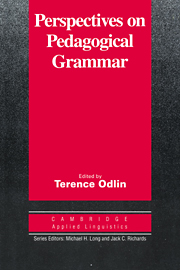Book contents
- Frontmatter
- Contents
- List of contributors
- Series editors' preface
- Preface
- Chapter 1 Introduction
- I WHAT SORT OF GRAMMAR?
- Chapter 2 Universal Grammar and the learning and teaching of second languages
- Chapter 3 Non-transformational theories of grammar: Implications for language teaching
- Chapter 4 Rules and pedagogical grammar
- II GRAMMAR, LEXICON, AND DISCOURSE
- III PUTTING GRAMMAR TO WORK
- Glossary
- Index
Chapter 4 - Rules and pedagogical grammar
Published online by Cambridge University Press: 05 October 2012
- Frontmatter
- Contents
- List of contributors
- Series editors' preface
- Preface
- Chapter 1 Introduction
- I WHAT SORT OF GRAMMAR?
- Chapter 2 Universal Grammar and the learning and teaching of second languages
- Chapter 3 Non-transformational theories of grammar: Implications for language teaching
- Chapter 4 Rules and pedagogical grammar
- II GRAMMAR, LEXICON, AND DISCOURSE
- III PUTTING GRAMMAR TO WORK
- Glossary
- Index
Summary
Introduction
One of the central tasks of pedagogical grammar is the formulation of rules, in the broad sense of the statement of language regularities. Yet the criteria for such rules are rarely discussed in any detail. According to one account, they should be: concrete, simple, nontechnical, cumulative, close to popular/traditional notions and in rule-of-thumb form (Hammerly 1982: 402); while in a recent critical overview, the following ‘design criteria’ are singled out: truth, clarity, simplicity, predictive value (i.e., precisely defining form-meaning relations), conceptual parsimony (i.e., being within the learner's current understanding) and relevance (i.e., taking account of LI-L2 contrasts and hypothesising interlanguage rules) (Swan 1992).
Such statements raise a number of complex practical issues, such as how a criterion like ‘simplicity’ is to be met, how rough, or vague, rules of thumb can be, and how systematically L1–L2 contrasts should be taken into account. There are also more basic speculative questions such as (a) what optimal (‘true’?) language rules really look like, (b) what pedagogical rules represent, in linguistic or psychological terms, (c) how such rules are perceived by their users and (d) how they relate to acquisition. The last two questions are, in principle, capable of empirical investigation, problematic though that is (Ellis 1990: ch. 8); but, in general, such issues are wide open.
- Type
- Chapter
- Information
- Perspectives on Pedagogical Grammar , pp. 72 - 96Publisher: Cambridge University PressPrint publication year: 1994
- 16
- Cited by

